Slips, Trips and Falls: Risks for Older Adults and Prevention Strategies for Care Settings
Slips, trips and falls are a leading cause of injuries among older adults, especially those in care homes or hospitals. Falls Prevention is necessary to stop increase in cases especially in care settings.
These incidents can severely impact mobility, independence, and quality of life.
However, many factors that contribute to falls are preventable through risk assessment, environmental adaptations, assistive equipment, staff training, and exercise programs.
A multi-faceted approach involving various stakeholders is crucial for safeguarding vulnerable residents.
This article explains slips, trips, and falls and highlights major fall prevention techniques within care settings.
We also delve into NICE guidelines and the responsibilities of healthcare workers, especially in protecting older people who are vulnerable.
What we covered [ Click Here]
Table of contents
- Defining Slips, Trips and Falls
- Common Slip Hazards to Look For
- Common Trip Hazards to Remove
- Common Fall Hazards to Address
- Risk Factors for Falls in Older Adults
- Why Falls Are Dangerous for Older People
- Checks on Fall Risk Assessments
- Home Adaptations to Prevent Falls
- Home Environment Assessment and Modification
- Environmental Design in Institutional Settings to Prevent Falls
- Mobility Aids and Assistance in Falls Prevention
- Falls Analysis: Medical and Medication Optimisation
- Assistive Equipment and Mobility Aids in Falls Prevention
- Physical Therapy and Exercise Interventions
- Protective Equipment Against Slips, Trips and Falls
- Training Care Staff on Fall Prevention
- Fall Prevention: Creating Safe Care Facility Environments
- Post-Fall Assessment and Intervention
- Preventing Falls: Following the Recommendations from NICE
- In Conclusion
- Recent Posts
- References
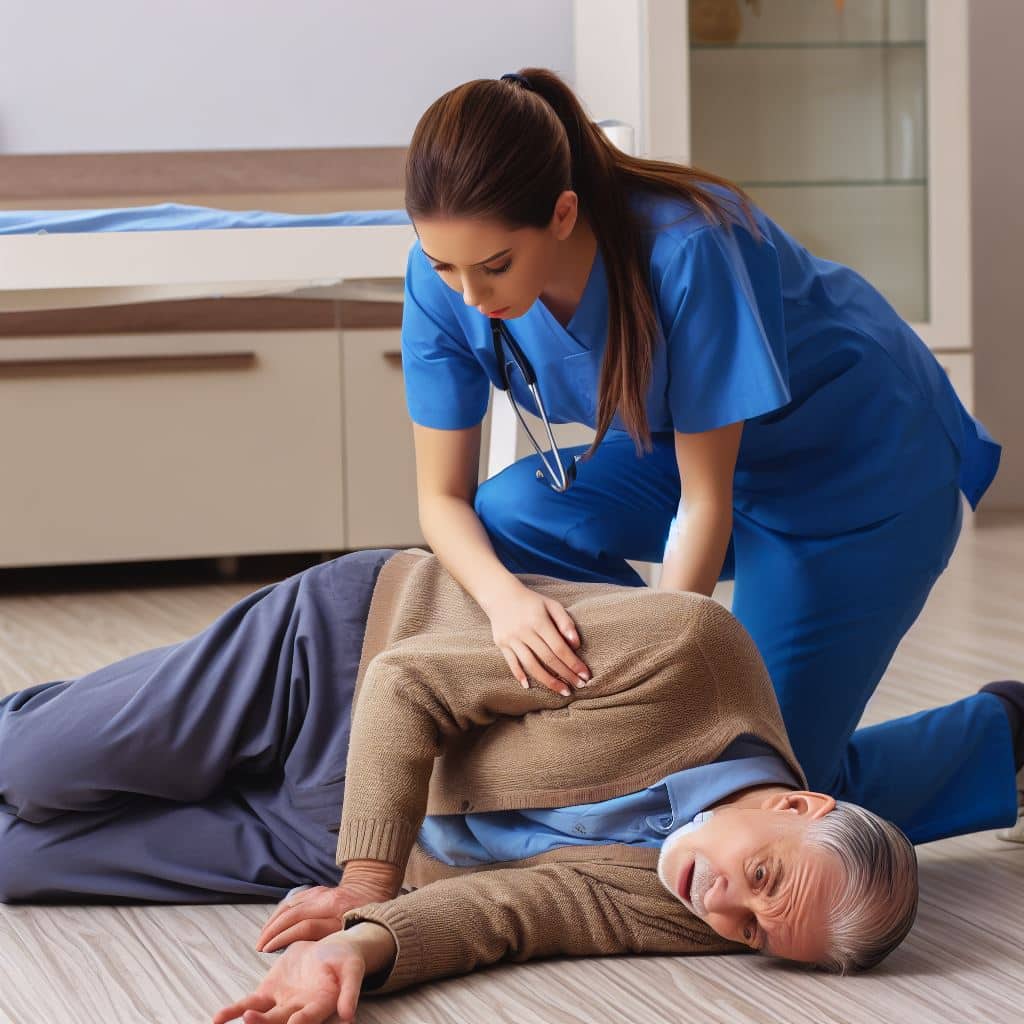
Defining Slips, Trips and Falls
Slips occur when traction is lost between the footwear and the walking surface, causing imbalance. This often results from wet, greasy or icy flooring.
Trips happen when legs hit an object, obstruction, or uneven surface, disrupting the normal walking motion and causing a loss of balance.
Falls result when the body loses balance completely after slipping or tripping and is unable to arrest descent. Falling to the floor or ground often leads to injury.
Check out our face to face Fall Prevention Training and learn about the course content.
Statistics on Slips, Trips and Falls
Slips, trips and falls lead to high rates of hospitalisation, disability, loss of independence, and reduced quality of life among older adults.
Key falls statistics include:
- Falls are the leading cause of fatal and non-fatal injuries for those aged 65+, responsible for over 36,000 elder deaths annually in the UK.
- Over 435,000 people aged 65+ visit the UK hospitals each year due to falls. This equates to about 1,200 admissions per day.
- Around 24% of UK care home residents fall each year. Falls account for 40% of all deaths from injury in care facilities.
- The cost to the NHS from falls by seniors exceeds £2.3 billion per year and is projected to surpass £3.6 billion by 2030.
Falls are a big problem that can cause a lot of harm. This is why it is important to take steps to prevent falls, especially in places where people are being cared for.
Common Slip Hazards to Look For
Slips occur when feet slip out from under someone on a slippery surface. Things that often cause slippery spots include:
- Water, grease or food spills on floors.
- Soap residue left on bathroom floors.
- Snow, water or mud tracked in from outdoors.
- Loose rugs, bathmats or other items that can slide.
- Waxed or shiny finished floors that are very slick.
All these slick surfaces can lead to dangerous slips.
But cleaning up spills right away, removing loose rugs and using slip-resistant floor finishes can help avoid slips.
Common Trip Hazards to Remove
Tripping happens when legs hit an object causing someone to lose balance and fall. Some examples of tripping dangers include:
- Electrical or oxygen tubes crossing pathways.
- Bunched up carpet edges or uneven surfaces.
- Items left in halls or doorways like carts or boxes.
- Thresholds or level changes between rooms or flooring.
- Poor lighting so people cannot see hazards.
Keeping walkways perfectly clear, adding nightlights in rooms and hallways, and fixing uneven floors reduces tripping risks.
Common Fall Hazards to Address
Sometimes the issue is not slipping or tripping but losing balance.
Things that can lead to falls include:
- Using ladders, step stools or chairs to reach high places.
- Climbing on beds, sofas or other furniture.
- Bending over without holding on to something sturdy.
- Reaching too far while sitting in chairs or wheelchairs.
- Standing up too quickly and getting dizzy.
- Using mobility aids that do not fit right.
Staying mindful, moving carefully, and using grab bars and proper steps can help avoid dangerous loss of balance.
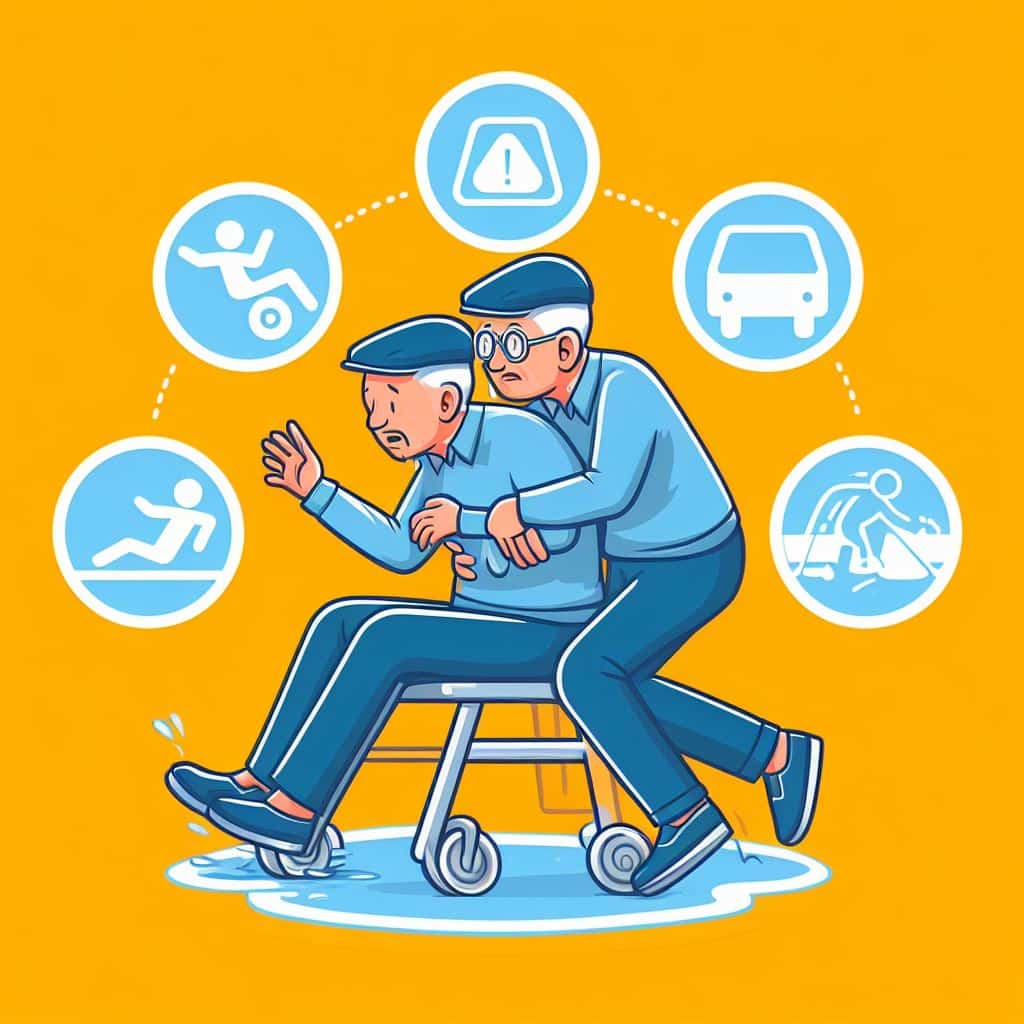
Risk Factors for Falls in Older Adults
Many older people are at risk of falling for several reasons:
- Weak muscles, difficulty walking, and balance problems due to aging, stroke, or arthritis.
- Memory and thinking issues from dementia, confusion, or certain medications.
- Declining eyesight because of conditions like macular degeneration1, glaucoma2, or cataracts3.
- Heart problems like low blood pressure, fainting, or irregular heartbeats.
- Brain conditions such as Parkinson’s disease4, nerve problems, or seizures.
- Fragile bones due to osteoporosis5, which can make injuries worse.
- Long-term health conditions and medications that cause dizziness or the need for frequent bathroom visits.
- Hazards in the home or care facilities that can lead to falls.
Identifying things/elements that can be adjusted enables more specific fall prevention strategies.
Get Certified Today- Take Our Online Training on Slips Trips and Falls – CPD Approved
Why Falls Are Dangerous for Older People
As people get older, falls can be very risky because:
- Bones become weaker and break more easily, like hips and wrists.
- Older individuals often take more medicines, which can sometimes cause dizziness or tiredness, increasing the risk of falls.
- Fading eyesight and hearing can make it more challenging for seniors to notice potential dangers.
- Slower reflexes mean they can’t react as quickly to regain balance when they start to fall.
- Joint pain or stiffness, particularly in knees or hips, can affect their balance.
Falls can lead to various problems for older people, such as:
- Broken hips, wrists, head injuries, bruises, and sprains.
- The need for hospitalisation, surgeries, infections, and prolonged bed rest, which weakens muscles.
- A loss of confidence, worries about falling, avoiding certain activities, and becoming more isolated.
- Health issues like blood clots, pneumonia, and pressure sores due to immobility.
- Having to use walking aids, wheelchairs, or needing more care.
- Reduced ability to do everyday tasks like getting dressed, bathing, and using the toilet.
- A higher chance of having to move into a care facility.
- A greater risk of passing away within a year after a fall.
Preventing falls is crucial for older people to have a better life and slow down their decline.
Checks on Fall Risk Assessments
The first step is formally evaluating individual risk factors:
- Medical history – Chronic conditions, medications, acute illness
- Physical exam – Gait6 and balance deficits, weakness, vitals, vision/hearing
- Functional evaluation – Ability with activities of daily living
- Environmental assessment – Home safety evaluation
- Psychosocial factors – Fear of falling, depression, loneliness
- Laboratory data – Electrolyte imbalances, anemia, vitamin D
Standardised tools help quantify risk and guide interventions. Risk should be rechecked regularly and after any falls to adjust plans.
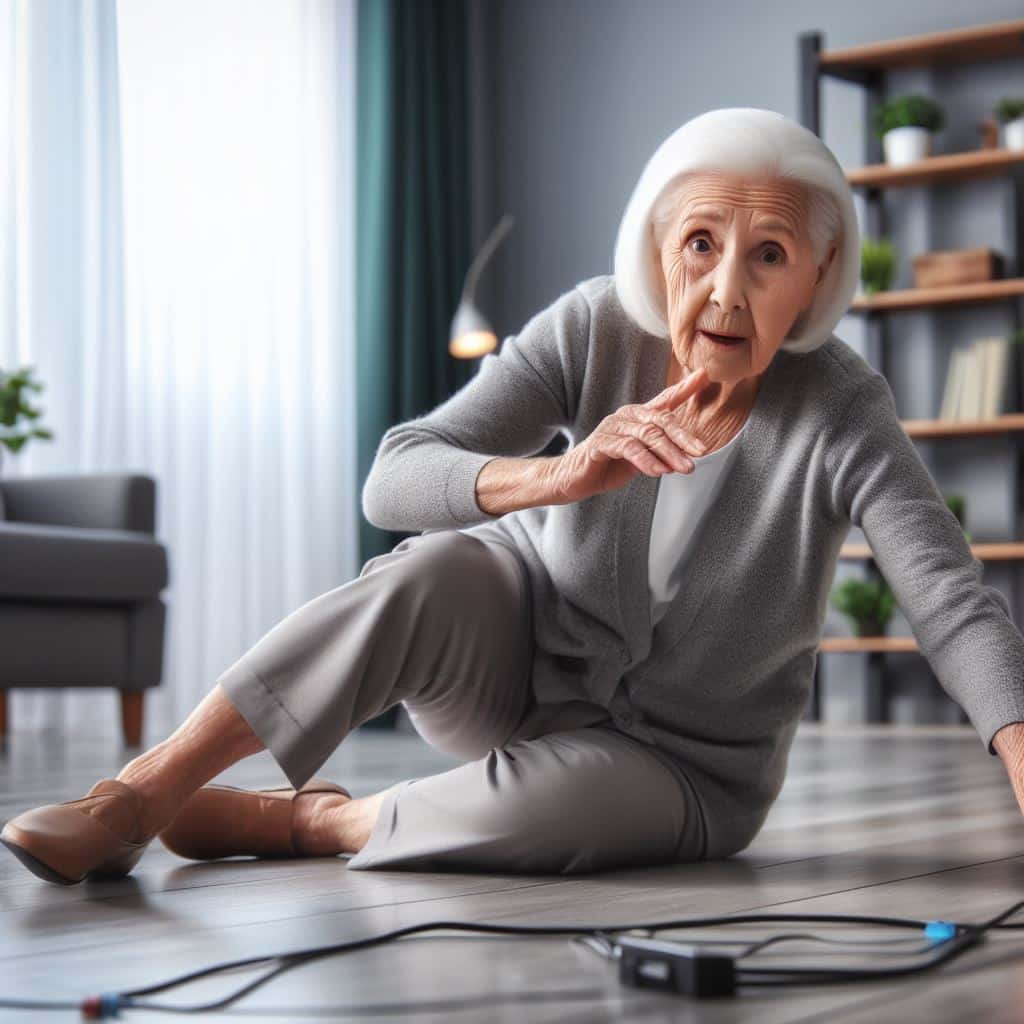
Home Adaptations to Prevent Falls
Simple home modifications can significantly reduce hazards:
- Improve lighting throughout, especially at entrances, stairs, and bathrooms. Install nightlights.
- Add grab bars in bathrooms near toilet and in tub/shower. Use shower seats.
- Apply reflective tape to stairs to highlight edges. Ensure steps have even rise/run and slip-resistant surfaces.
- Remove loose rugs and cords crossing walkways. Consider changing to low-pile carpets.
- Rearrange furnishings to create wide clear pathways. Remove clutter creating tripping risks.
- Use chairs with armrests that make rising easier. Ensure proper height beds and toilets.
- Have phones and call buttons accessible from bed and other frequent locations.
A home occupational therapy evaluation can identify needed adaptations.
Home Environment Assessment and Modification
A home assessment identifies hazards to eliminate.
The goal is to identify potential safety hazards and make necessary modifications to ensure the facility or home is safe and suitable for the needs of the individual.
Home Environmental Assessment involves checking for things like:
- tripping hazards,
- adequate lighting,
- handrails, and
- other factors that can impact a person’s safety and mobility within their home/facility.
Simple home modifications can significantly reduce hazards:
1. Flooring
- Ensure carpeting is low-pile, non-slip, and secured firmly with no lifted edges.
- Remove small loose rugs or use non-slip backing.
- Repair cracked, uneven surfaces that could trip users.
- Keep highly glossy floors free of water, debris, and clutter.
2. Lighting
- Provide adequate illumination in all rooms, stairs, and entrances.
- Ensure lighting switches are easy to access from entrances.
- Use maximum wattage bulbs allowed in fixtures.
- Install nightlights to illuminate paths between bedroom, bathroom, and stairs.
3. Stairs
- Confirm railings are tightly secured on both sides of stairs.
- Apply bright reflective tape to top and bottom stairs to highlight edges.
- Eliminate raised lips between floors and landings.
- Keep stairs free of objects. Never store items temporarily on stairs.
4. Hazards
- Remove coil or tape cords and wires out of walkways.
- Secure loose carpets and matts.
- Remove furniture clutter blocking paths.
- Use cordless phones to avoid rushing for phone.
- Mount grab bars in bathrooms near toilet and shower entrance.
- Use shower chairs and tub transfer seats.
5. Entryways
- Ensure outdoor steps have railings and adequate lighting.
- Keep walkways even and clear of debris, snow, and ice.
- Place mats firmly so they do not shift.
7. Bedroom
- Position bed for easy access from both sides.
- Install bedside lighting within easy reach.
- Have telephone and call button close but not hazardous.
- Avoid bedroom clutter than can be tripping hazards.
8. Kitchen
- Store commonly used items within easy reach.
- Provide stable step stools for hard-to-reach cabinets.
- Avoid use of chairs or surfaces not meant as steps.
Personalised home hazard assessments help find risks that can be fixed.
Get Certified – Complete Our Falls Prevention Online Course – CPD Approved
Environmental Design in Institutional Settings to Prevent Falls
Modifications to care settings like hospitals and nursing homes include:
- Color code unique paths through facilities using distinct flooring patterns, wall colours or themes.
- Provide adequate directional signage and room numbers for clear wayfinding.
- Eliminate changes in flooring height between rooms or hallways.
- Keep hallways uncluttered with ample seating alcoves for rest breaks.
- Use contrasting colors on toilet seats, door frames, bed rails, stair edges, and grab bars for easier recognition.
- Install non-slip tread on stairs. Improve lighting over stairs and entrances.
- Have ample means of summoning assistance like call buttons, phones, audible alarms.
- Use pressure sensor mats that alarm if someone tries to leave beds or chairs unattended.
Environmental design changes promote safe mobility for patients and residents.
Mobility Aids and Assistance in Falls Prevention
Mobility aids and assistance are tools and support that help people move safely, reducing the risk of slips, trips, and falls.
This includes items like canes, walkers, wheelchairs, and grab bars, as well as help from caregivers or staff to prevent accidents.
Mobility aids provide needed support while maintaining independence. Here are some things to keep in mind when using mobility aids:
- Fit individuals with appropriate assistive devices like canes, walkers, or wheelchairs and provide training until proficient in use.
- Check regularly that aids are in good repair, fitted properly, and used as directed.
- Remind users to lock brakes before standing up from chairs and wheelchairs.
- Encourage use of aids at first sign of unsteadiness rather than waiting until at higher fall risk.
- Provide standby assistance or hands-on support only as needed for safety during walking or transfers. Avoid over-assisting.
Matching aids to user and task enables mobility with confidence.
Falls Analysis: Medical and Medication Optimisation
Evidence-based medicine adjustments include:
- Reviewing all medicines for types linked to dizziness or syncope. Lowering psychoactive drug doses if possible.
- Providing vitamin D supplementation to improve muscle strength and bone density.
- Evaluating and treating vision and hearing issues to optimize input affecting balance.
- Managing cardiovascular disorders, such as carotid stenosis or arrhythmias, that increase fainting risk.
- Conducting medication reconciliation to eliminate unnecessary medications.
- Treating arthritis, diabetes, Osteoporosis, and other conditions contributing to pain, neuropathy and falls.
Therapeutic remedies reduce intrinsic fall risks.
Assistive Equipment and Mobility Aids in Falls Prevention
Devices provide needed stability and support:
- Canes or walkers – Improve balance while walking.
- Grab bars – Assist with transitions like standing up or getting in/out of bath.
- Reachers – Allow grasping items without over-extension.
- Proper footwear – Shoes with arch support, cushioning and non-slip soles. Avoid socks or smooth floors.
- Assistive tech – Sensors that alert carers to attempts to rise unsupervised. Personal alarms summon help after a fall.
Ensuring aids suit user needs and environment promotes safe mobility.
Get Certified – Complete Our Falls Prevention Online Course – CPD Approved
Physical Therapy and Exercise Interventions
Research confirms properly prescribed exercise reduces fall rates and severity through improving strength, flexibility, balance and stability.
Recommended programs involves:
- Muscle strengthening – Legs, core, hips, shoulders.
- Balance training – Heel-to-toe walking, Tai Chi, reducing base of support.
- Gait and mobility practice – Walking aids, changing direction, uneven surfaces.
- Stretching – Yoga, Pilates, maximizing joint flexibility.
- Endurance – Low-impact cardio like recumbent bikes.
A physical or occupational therapist can tailor exercise regimens to individual abilities. Consistency is key. Even chair exercises improve mobility.
Balance, Strength and Gait Training
Balance, Strength, and Gait Training are exercises that help people in care settings (including seniors) become steadier, stronger, and better at walking.
These exercises reduce the risk of residents slipping, tripping, or falling by improving their ability to stay balanced and react quickly to avoid accidents.
Targeted exercise programs improve stability, but always ensure that it is done by a professional.
Some of the things to consider for the training are:
- Tailor flexibility, balance, coordination, and leg strengthening exercises to individual’s baseline abilities. Focus on core and lower body.
- Add balance challenges like standing on one foot, walking heel to toe, and proprioceptive exercises.
- Use weighted vests and resistance bands to improve muscle strength needed for support and recovery.
- Practice standing up and sitting down frequently with or without use of upper limbs.
- Re-train proper gait mechanics through walkway marking, mirrors, and feedback on posture and stride length.
- Consider referral for physical or occupational therapy evaluation to develop personalised exercise programs if needed.
Regular exercise helps prevent falls.
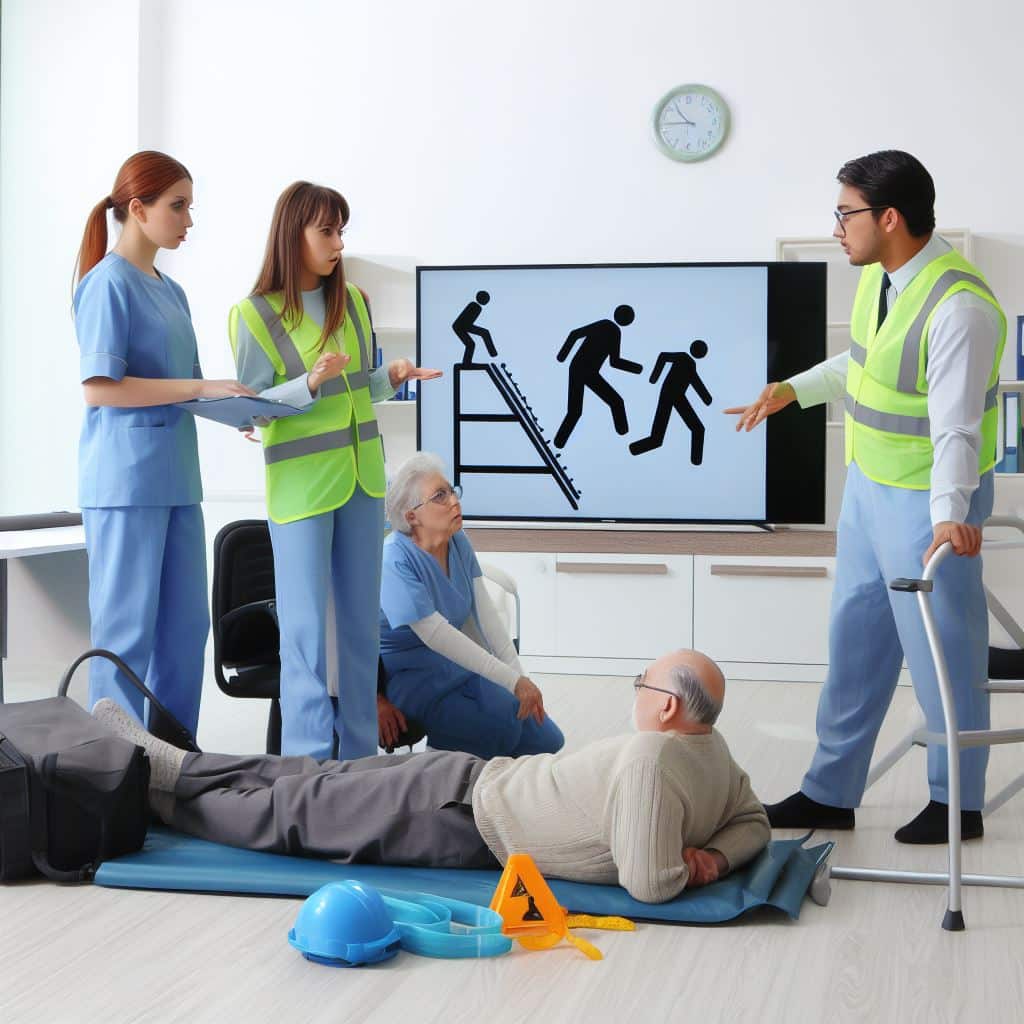
Protective Equipment Against Slips, Trips and Falls
Protective accessories cushion against impact:
- Wear sturdy shoes with non-slip soles that fit well. Avoid walking in socks or smooth soles.
- Use shatter-resistant lenses and side shields on eyewear.
- Protect joints with wrist guards, helmets, hip protectors, and knee pads.
- Place cushioning floor mats or pads near beds, chairs, and showers.
- Use trapeze handles or lifts above beds for those at a high risk of falling.
- Wear alarm devices that call for help after a fall.
Additional equipment makes things safer.
Training Care Staff on Fall Prevention
Equipping staff helps sustain safety:
- Education on identifying fall risks and prevention techniques.
- Training on proper use of mobility equipment – walkers, wheelchairs, lifts.
- Skills practice providing mobility assistance like transfers.
- Protocols for frequent safety reminders and risk prompt communication across caregiver shift changes.
- Monitoring program participation and outcomes to fine-tune training.
Standardizing competencies ensures consistent fall prevention application.
Fall Prevention: Creating Safe Care Facility Environments
Hospitals and care homes can implement building-wide safeguards like:
- Keeping floors clean, dry, even, and slip-resistant. Promptly wiping spills. Using warning signs for wet floors.
- Removing trip hazards in hallways and rooms. Securing mats, cords, and carpet edges.
- Conducting routine safety checks of furnishings, fixtures, rails, call systems. Repairing hazards promptly.
- Ensuring adequate lighting throughout facility and grounds, especially at changes in floor height. Installing night lights.
- Providing handrails on both sides of corridors. Painting contrasting colors on stairs.
- Furnishing activity rooms and resident lounges with stable armchairs and seating that is easy to rise from.
- Using patient identifiers like wristbands or photos before assisting mobility or administering medications to prevent treatment errors that could cause dizziness.
Environmental adjustments protect entire populations long-term.
Making Kitchen and Dining Areas Safer
Kitchens have lots of risks like spills, especially in care homes. Important safety steps are:
- Cleaning up all spills quickly to avoid slips.
- Allowing only staff in the kitchen to avoid burns.
- Keeping hot food and liquid out of reach of residents.
- Having sturdy armless chairs with grab bars for easy rising.
- Providing plates and cups with special grips and edges if needed.
Eating areas must have good chair supports and slip-resistant floors.
Fall Preventive Measures- Improving Bathroom Safety
Bathrooms have lots of slick surfaces. Helpful ideas include:
- Putting out warning signs when floors are wet.
- Adding extra grab bars, shower seats and rubber mats.
- Always using non-slip bathmats with rubber backing.
- Providing stairs or bath lifts if tubs are hard to enter.
- Adding higher toilets and using toilet frames with arms.
- Checking water temperature to avoid burns with a thermometer and recording it.
Handrails, shower grab bars, floor mats and raised toilets or toilet seats reduce the chance of sliding in bathrooms.
Enhancing Bedroom Safety for fall prevention
Bedrooms have their own risks to avoid:
- Keeping floor areas around beds and dressers free of objects.
- Providing lamps and nightlights that are easy to reach from bed.
- Making sure call bells for help are always close by.
- Adding grab bars, handles or steps for those with tall beds.
- Using monitors or sensors that alert staff if someone tries to leave bed.
Bedroom hazards can be lessened with lighting, cleared spaces, easy access to help and steps for high beds.
Improving Overall Safety
Some general things that help lower risks everywhere include:
- Regular cleaning of eyeglasses for the clearest vision.
- Providing mobility aids like canes, walkers and wheelchairs fitted to each person and checking they are in good shape.
- Putting handrails on both sides of all stairs and hallways.
- Adding good lighting everywhere indoors and outside.
- Ensuring proper indoor and outdoor lighting.
- Keeping extension cords and power strips out of pathways.
- Using chairs with armrests that make rising easier.
- Having activities to build strength, balance and coordination
Frequent checks ensure the environment helps prevent tumbles.
If care and hospital workers all join in and follow proven steps to prevent falls, the risk can be significantly lowered, helping even frail adults stay strong.
A careful and forward-looking strategy that concentrates on keeping residents safe while moving increases their confidence and helps them stay active.
Post-Fall Assessment and Intervention
A post-fall assessment and intervention is the process that follows a fall. It involves examining why the fall occurred, assessing any injuries or changes in the person’s condition, and taking steps to prevent future falls.
This may include adjusting the person’s care plan, making changes to the environment, or providing additional support to enhance their safety and well-being.
What should you do after a fall?
After a fall, key responses include:
- Stay with the person and provide comfort while waiting for help.
- Give first aid if there are any injuries or bleeding.
- Check the person’s nervous system and blood circulation and keep an eye on their vital signs for confusion or delayed reactions.
- Discuss the situation and what caused the fall with the staff in a post-fall meeting.
- Update risk assessments and care plans to address any new issues.
- Increase supervision or monitoring if the person is confused, in pain, or agitated.
- Arrange for tests like X-rays if there might be fractures, head injuries, or internal bleeding based on how severe the symptoms are.
- Help the person overcome their fear of falling by offering counseling and teaching them how to move safely.
Organisations can lower the chances of falls and help those at risk stay mobile and independent by using proven methods and keeping the environment safe.
Creating a culture of being careful, talking well, and taking care of people helps them stay healthy and live longer.
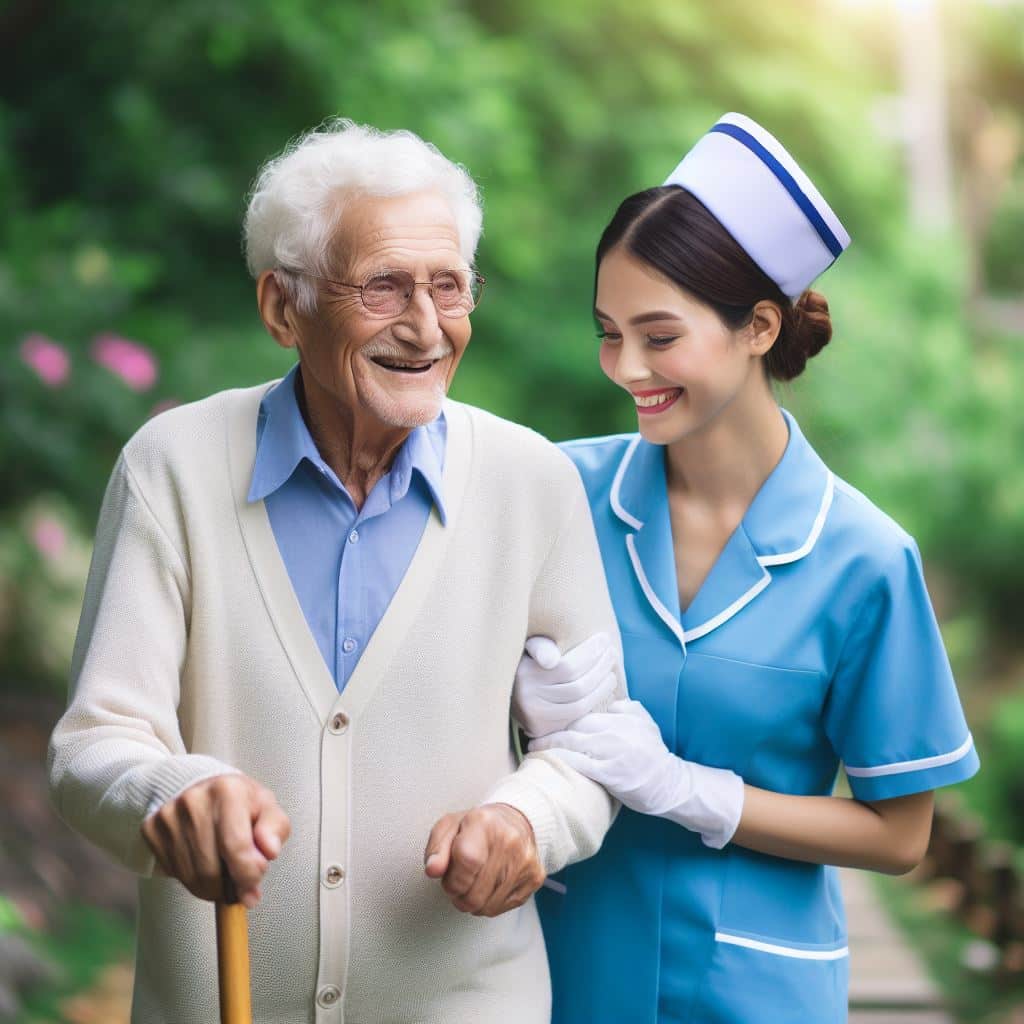
Preventing Falls: Following the Recommendations from NICE
The National Institute for Health and Care Excellence (NICE) publishes advice on preventing falls, especially for older adults. These guidelines help health and care providers promote safer, healthier ageing – reducing the risk of falls and enhancing independence.
The NICE guidelines for fall prevention include:
- assessing fall risks,
- medical reviews,
- exercise programs,
- home safety checks,
- practical support, and
- ongoing risk monitoring.
So, let’s examine each aspects of the NICE guidelines to help prevent fall within the care settings.
Assessing Fall Risks
NICE advises checking all older people for fall risks. Ask about any falls in the past year. Look for issues like:
- Unsteady walking or needing help to move around.
- Falling more than once.
- Feeling dizzy or faint often.
- Unable to get out of a chair without using arms.
- Difficulty seeing or hearing.
- Problems thinking clearly or understanding.
- Taking medicines that make you sleepy or dizzy.
- Needing to rush to the toilet.
- Fear of falling that limits your activity.
Checking for risks helps identify who needs more help.
Medical Reviews
For those at high risk of falling, NICE suggests:
- Checking all medicines to see if any make falls more likely. Lower doses if possible.
- Testing vision and hearing and referring for treatment if necessary. Poor vision or hearing can affect balance.
- Conducting a full medical review to assess issues like dizziness, foot pain, heart rate problems, and more that could affect falls.
- Discussing options like adjusting medicine doses or physical therapy to improve balance.
- Checking bone strength if there are risks like osteoporosis and starting preventive treatment if needed.
- Assessing feet and stumbling risks and providing inserts or footwear advice when necessary.
Thorough reviews identify health factors to address.
Exercise Programs
For older adults who have fallen or are unsteady, NICE strongly recommends exercise programs to increase strength, balance, and coordination. Recommended programs include:
- Muscle strengthening exercises using weight machines, resistance bands, or body weight.
- Balance training through activities like backward walking, heel-to-toe steps, and Pilates.
- Tai Chi classes tailored to older users.
- Individual or group sessions with trained fitness instructors.
- Consistent exercise 2-3 times per week for at least 6 months.
- Referring for a physical therapy assessment if needed.
Staying active provides greater stability and confidence.
Home Safety Checks
NICE states that trained healthcare workers should make home visits after falls to suggest changes. They recommend:
- Improving lighting indoors and outside entrances, and adding nightlights.
- Adding grab rails in bathrooms and using bath seats.
- Removing tripping risks like rugs, clutter, and cables.
- Providing stable chairs and adjusting chair and bed heights.
- Installing ramps if needed and fixing outdoor walkways.
- Using slip-resistant mats and shower grips.
- Having emergency alarms or call buttons.
- Adjusting storage so things are within easy reach.
Removing hazards provides a safer environment.
Practical Support
For daily functioning, NICE guidelines suggest:
- Reviewing all aids like canes, walkers, and braces to ensure a suitable fit and proper training, and replacing worn grip handles.
- Providing mobility aids early rather than waiting until it’s very limited.
- Putting care plans in place for high-risk times like during illnesses.
- Having regular eye checks and providing new eyeglasses promptly when needed.
- Suggesting protective hip guards and helmets for those prone to falling.
- Ensuring adequate pain relief when needed.
Practical support aids independence and activity.
Information for Older Adults
NICE advocates giving older people tips on:
- How to correctly use walking aids and how to get up safely after a fall.
- Doing exercises to improve strength and balance and offering group classes.
- Having regular eye tests and getting new glasses on time.
- Watching out for trip hazards at home like rugs, pets, and clutter.
- Wearing shoes that provide good support and grip and avoiding slippery soles.
- Being cautious when walking in winter weather.
- Reporting any concerns about dizziness or unsteadiness early.
Informed people can better protect themselves.
Ongoing Risk Monitoring
For those at an elevated risk of falling, NICE recommends:
- Conducting frequent reviews to check current risk status and needs and updating plans.
- Referring back to the medical team promptly if new problems arise.
- Providing refreshers on home modifications, exercise routines, and aids.
- Reassessing medicines regularly for effects like drowsiness.
- Following up after any falls to understand why they occurred and updating interventions based on insights.
- Offering emotional support alongside practical assistance.
Regular checks sustain helpful actions over time.
In Conclusion
it’s really important to be watchful and take action to stop slips, trips, and falls. This is a big deal for the safety and happiness of older people.
Falls prevention in care settings takes dedication, but it is highly beneficial for helping older people remain active and independent.
Following NICE guidelines on checks, health reviews, home changes, exercise programs, and practical support offers a proven plan. Staying alert to emerging needs is also crucial.
With the right preparation, people can stay comfortably mobile even as risks increase with age.
Recent Posts
- Basic Life Support Checklist -PDF Download Available
- Safeguarding Training Levels: How to choose the right training
- Caring For Care Partners with AquAid to Support Installation of Elephant Pumps in Africa
- Wound Assessment and Documentation: Mastering Key Steps for Better Care
- Understanding Bereavement Support and Duties of Different Healthcare Groups.
References
- Macular degeneration is an eye condition that causes damage to the macula, which is the central part of the retina. ↩︎
- Glaucoma is an eye condition characterised by increased pressure within the eye, which can damage the optic nerve. Glaucoma is a leading cause of blindness worldwide. ↩︎
- Cataracts are like a cloudy cover over the eye’s lens, making the vision blurry and less clear. It’s common as people get older and can be fixed with surgery. ↩︎
- Parkinson’s disease is a medical condition (neurological disorder) that affects movement. It can cause symptoms like tremors, stiffness, and difficulty with balance and coordination. ↩︎
- Osteoporosis is a condition where the bones become weak and brittle, making them more likely to fracture or break. It is often referred to as “brittle bone disease.” Osteoporosis is common in older adults and can lead to fractures, especially in the hip, spine, and wrist. ↩︎
- Gait refers to the way a person walks or moves their legs when they walk. It involves the pattern and rhythm of steps while walking. ↩︎
Let us Help you
We’ll help you find the right course for your needs. Tell us a little bit about your situation and what you would like to achieve.
We’ll get back to you within one working day.
